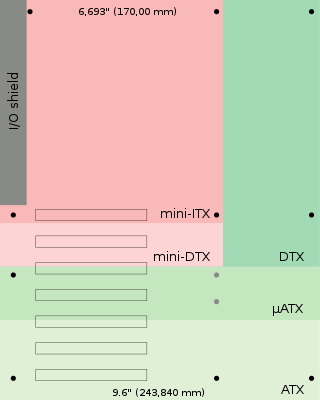
Mini-ITX is a 170 mm × 170 mm motherboard form factor developed by VIA Technologies in 2001. Mini-ITX motherboards have been traditionally used in small-configured computer systems. Originally, Mini-ITX was a niche standard designed for fanless cooling with a low power consumption architecture, which made them useful for home theater PC systems, where fan noise can detract from the cinema experience.

Micro-Star International Co., Ltd. is a Taiwanese multinational information technology corporation headquartered in New Taipei City, Taiwan. It designs, develops and provides computer hardware, related products and services, including laptops, desktops, motherboards, graphics cards, all-in-one PCs, servers, industrial computers, PC peripherals, car infotainment products, among other products.
Anand Lal Shimpi is a former tech journalist and American businessman who retired at the age of 32 from the publishing industry to join the hardware division at Apple Inc. He is primarily known as the founder of the technology website AnandTech, a hardware news/review site which started as motherboard reviews hosted on GeoCities. At that time Anand was just 14 years old and over a period of 17 years it grew to be one of the most respected sites for tech reviews. He also wrote a book in 2001, named "The Anandtech Guide to PC Gaming Hardware".
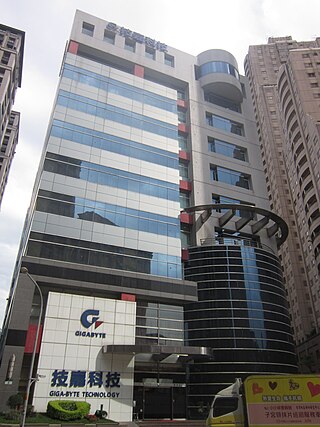
Gigabyte Technology is a Taiwanese manufacturer and distributor of computer hardware.
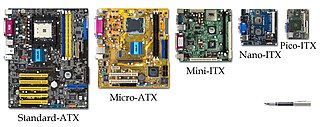
Small form factor is a term used for desktop computers and for some of its components, chassis and motherboard, to indicate that they are designed in accordance with one of several standardized computer form factors intended to minimize the volume and footprint of a desktop computer compared to the standard ATX form factor.

Haswell is the codename for a processor microarchitecture developed by Intel as the "fourth-generation core" successor to the Ivy Bridge. Intel officially announced CPUs based on this microarchitecture on June 4, 2013, at Computex Taipei 2013, while a working Haswell chip was demonstrated at the 2011 Intel Developer Forum. Haswell was the last generation of Intel processor to have socketed processors on mobile. With Haswell, which uses a 22 nm process, Intel also introduced low-power processors designed for convertible or "hybrid" ultrabooks, designated by the "U" suffix. Haswell began shipping to manufacturers and OEMs in mid-2013, with its desktop chips officially launched in September 2013.

ASRock Inc. is a Taiwanese manufacturer of motherboards, industrial PCs and home theater PCs (HTPC) that established on May 10, 2002.

Cooler Master Technology Inc. is a computer hardware manufacturer based in Taipei,Taiwan. Founded in 1992, the company produces computer cases, power supplies, air and liquid CPU coolers, laptop cooling pads, and computer peripherals. Alongside its retail business, Cooler Master also is an original equipment manufacturer of cooling devices for other manufacturers, including NVIDIA, AMD, and EVGA. The company has sponsored major eSports events. Some of Cooler Master's products have won awards including the iF product design award.

LGA 1150, also known as Socket H3, is a zero insertion force flip-chip land grid array (LGA) CPU socket designed by Intel for CPUs built on the Haswell microarchitecture. This socket is also used by the Haswell's successor, Broadwell microarchitecture.
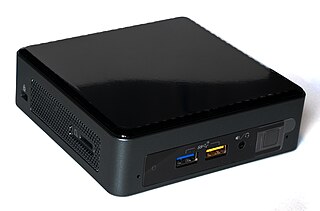
Next Unit of Computing (NUC) is a line of small-form-factor barebone computer kits designed by Intel. It was previewed in 2012 and launched in early 2013. The NUC has developed over ten generations, spanning from Sandy Bridge-based Celeron CPUs in the first generation through Ivy Bridge-based Core i3 and i5 CPUs in the second generation to Gemini Lake-based Pentium and Celeron CPUs and Kaby Lake-based Core i3, i5, and i7 CPUs in the seventh and eighth generations. The NUC motherboard usually measures approximately 10 × 10 centimetres (4 × 4 in), although some models have had different dimensions.

LGA 1151, also known as Socket H4, is a type of zero insertion force flip-chip land grid array (LGA) socket for Intel desktop processors which comes in two distinct versions: the first revision which supports both Intel's Skylake and Kaby Lake CPUs, and the second revision which supports Coffee Lake CPUs exclusively.

Kaby Lake is Intel's codename for its seventh generation Core microprocessor family announced on August 30, 2016. Like the preceding Skylake, Kaby Lake is produced using a 14 nanometer manufacturing process technology. Breaking with Intel's previous "tick–tock" manufacturing and design model, Kaby Lake represents the optimized step of the newer process–architecture–optimization model. Kaby Lake began shipping to manufacturers and OEMs in the second quarter of 2016, with its desktop chips officially launched in January 2017.

Socket AM4 is a PGA microprocessor socket used by AMD's central processing units (CPUs) built on the Zen and Excavator microarchitectures.
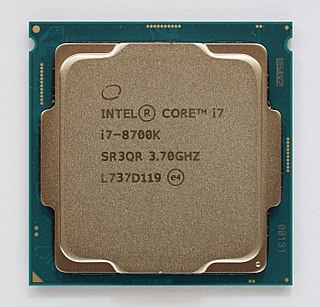
Coffee Lake is Intel's codename for its eighth-generation Core microprocessor family, announced on September 25, 2017. It is manufactured using Intel's second 14 nm process node refinement. Desktop Coffee Lake processors introduced i5 and i7 CPUs featuring six cores and Core i3 CPUs with four cores and no hyperthreading.
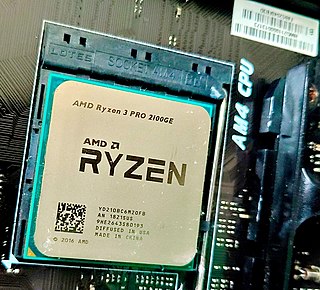
Ryzen is a brand of multi-core x86-64 microprocessors designed and marketed by Advanced Micro Devices (AMD) for desktop, mobile, server, and embedded platforms based on the Zen microarchitecture. It consists of central processing units (CPUs) marketed for mainstream, enthusiast, server, and workstation segments and accelerated processing units (APUs) marketed for mainstream and entry-level segments and embedded systems applications.

Phanteks is a Dutch company which mainly produces PC cases, fans and other case accessories. The company has a base in the United States.

RDNA is a graphics processing unit (GPU) microarchitecture and accompanying instruction set architecture developed by AMD. It is the successor to their Graphics Core Next (GCN) microarchitecture/instruction set. The first product lineup featuring RDNA was the Radeon RX 5000 series of video cards, launched on July 7, 2019. The architecture is also used in mobile products. It is manufactured and fabricated with TSMC's N7 FinFET graphics chips used in the Navi series of AMD Radeon graphics cards.

Socket AM5 is a zero insertion force flip-chip land grid array (LGA) CPU socket designed by Advanced Micro Devices (AMD) that is used for AMD Ryzen microprocessors starting with the Zen 4 microarchitecture. AM5 was launched in September 2022 and is the successor to AM4.



















